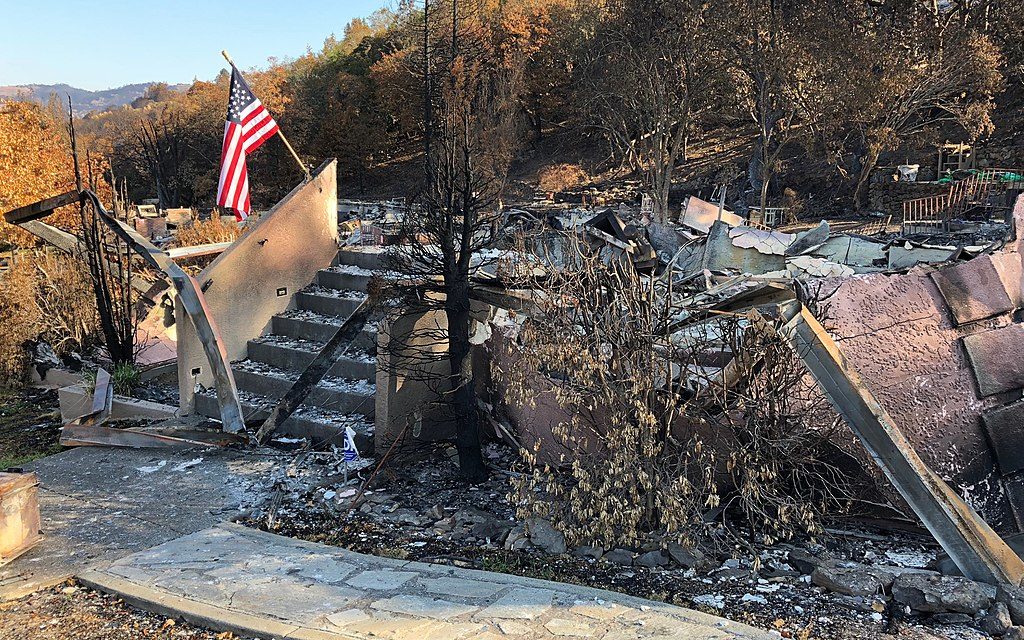In 2018 the Camp Fire, California’s deadliest and most destructive wildfire, killed 85 people, virtually destroying the entire town of Paradise and shrouding large swaths of Northern California in a two-week haze of toxic smoke. Just a year before, my home community of Sonoma County, about 200 miles southwest of the Camp Fire, was engulfed in a fire which claimed 44 lives. These climate-change-related death tolls are the new normal, linking California with the growing masses of climate migrants around the globe.
These tragic disasters have a disproportionate impact on communities of color and shelterless populations. They are the same communities that have been subjected to centuries of oppression and exploitation by the very capitalist, white supremacist, and patriarchal economic systems that created and continue to uphold inequities and competition for scarce resources across race, class, and gender lines.
As communities struggle to put their lives back together, corporate entities fall back into building the same, flammable homes, regardless of the risk to property and lives. Companies are rapidly rebuilding homes to maximize profits. But what do we sacrifice for the sake of speed? Business-as-usual is rebuilding-to-burn. Nevertheless, some communities are starting to consider other approaches, and are mobilizing towards a new, collective vision. Grassroots organizers know that when we design for — and with — front-line communities, we design a better system for all.
For several weeks last year, when the Camp Fire thrust Northern California into the category of “poorest air quality in the world,” I, along with millions of Californians attained a renewed appreciation for clean air. I realized that to ensure clean air for all, we must regain a wildfire-adapted culture, like the culture that indigenous Californians had for millennia, and which shaped the abundant landscapes that settlers extracted upon arrival.
To adapt to the constant threat of wildfires, we need to revisit the purpose and function of the built environment, and find a way to construct communities that mimic how indigenous Californians sheltered themselves.
Lisa Kleissner, treasurer of the Community Association of Big Sur, is an advocate for the need to allocate capital to incentivize fire-resistant new construction and retrofits. In California,“folks are working with what they have (i.e. low or no-cost protection options) to address the constant threat of wildfire,” explains Kleissner. “Addressing the reality of climate change and its impact on our communities requires action on the part of the residents, homeowners, and municipality, not just CalFire.”
Kleissner believes that we can and must defend our own homes and that state and federal resources dedicated to fire suppression must be better leveraged. “Capital used to fight fires should, in part, be used to provide tax incentives and low cost long-term debt to enable retrofitting of structures,” says Kleissner.
While research is being done around fire-resistant construction strategies, much of it does not take into account the need for the building industry to reduce its sizeable contributions to the climate crisis, which exacerbates the severity of fires in California and beyond. The building sector accounts for 39 percent of U.S. Carbon emissions according to the U.S. Green Building Council.
Benefits of natural building
Citizens reason that we cannot fight climate-caused disasters with the same mindset that created them, nor can we pretend to create community resilience by using high-carbon emitting materials in rebuilding; we have to imagine a different path forward. That path will include natural building strategies such as rammed earth, straw-bale buildings, green roofs and home hardening. Natural building generally refers to a philosophy of construction that favors durable, minimally processed sustainable materials such as straw, wood, and clay in creating human shelters.
Nearly all of the buildings designed by the ecological architecture firm Arkin Tilt within or adjacent to wildfire-affected areas survived the North Bay wildfires. Although natural building has been criticized for being costly, it is possible to build fire-resistant homes at a similar cost to conventional building. Arkin Tilt made plans available for free to anyone who had lost their homes in a wildfire.
The additional benefits of natural building include homes that are nontoxic for the workers to construct (and for people to live in) and that are able to withstand a seismic event. In some cases, homes could be designed as emergency shelter-in-place oases, protecting families indoors in an extreme wildfire. The designs could incorporate rainwater harvesting and gray-water reuse to help address California’s water crisis; and they can utilize community-owned power (even off-grid), from organizations such as People Power Solar Cooperative, and Sonoma Clean Power.
Another benefit of natural building is the potential to address climate change. The straw, wood, or other materials are made up of what was previously atmospheric carbon transformed via photosynthesis in contrast to conventional building materials created via processes which emit carbon into the atmosphere. Natural materials are then integrated into the construction in a way that permanently preserves that carbon in the building envelope, constituting “sequestered carbon.”
Preliminary findings from California Straw Building Association (CASBA) (currently in review by ARUP Engineering) show the Mahonia mixed-use building, near downtown Eugene, Oregon, measures 12.1 metric tons of carbon (CO2e) sequestered. This commercial mixed-use structure was built with straw, wood framing, and clay in place of the more typical materials used in commercial construction: metal framing and foam insulation. These findings compared the total embodied carbon of the straw bale/clay plaster wall assembly with the embodied carbon of a comparable typical commercial wall assembly, and the highlight just how powerful natural construction can be for addressing climate change.
Straw, a waste product of California’s rice and grain industries, has been used for millennia in buildings as a highly-insulative building material. Furthermore, it can be grown via methods that restore degraded lands, as is being done by regenerative viticulturist Kelly Mulville at Paicines Ranch. Mulville sees the production of straw as a co-benefit of restoring an overgrazed section of the ranch.
Despite straw-bale construction being an approved building method under international codes, we need more public education and visible pilot projects. Massey Burke, co-director of CASBA and a natural materials design/build consultant, says that CASBA and ARUP are partnering with StopWaste to develop a carbon-sequestering multifamily housing project in the East Bay, and more generally to support the growth of carbon-sequestering construction practices.
“Citizens can participate in our upcoming workshops such as a skills-training workshop on August 10 and 11 teaching how to complete a straw bale retrofit to an existing home,” says Burke.
Training the Next Generation of Builders
We have an opportunity to train up a new wave of builders. Our youth are inheriting an increasingly insecure job market. Youth unemployment has been rising and a recent survey showed that 29 percent of millennials regret their college degrees. The predictability of home loss to natural disasters in the future means that developing tangible skills in rebuilding from natural disasters is job security.
Letitia Hanke, founder of The LIME Foundation‘s NextGen Trades Academy in Sonoma County, says the school covers natural building techniques in its green building curriculum because it believes in nontoxic work pathways for its students. The program trains and helps youth find gainful employment in the construction industry and builds a workforce for local contractors. She says the program has a success rate of more than 60 percent in finding full-time job placements for participants.
“We hope to train hundreds of youth to be able to build tiny homes with nontoxic materials for the sake of our climate and our world,” says Hanke, who is also the award-winning business-owner of ARS Roofing.
Workforce development in the natural building industry is also in the works at California Human Development, a nonprofit organization focused on fighting poverty. CHD is thinking proactively about what can be done to retrofit communities to prevent future disasters, with plans to retrofit an existing vacant building and to transform it into a fire-resistant model for natural-building retrofit and sober living center. “We especially target the most vulnerable in our communities with no benefit of extra safety nets when disaster hits,” says Kai Harris, CDH’s program director. “We are pleased to be integrating natural building principles into our workforce development and building techniques so that we can move into a new era of climate and community resilience.”
And finally, we need code shifts. While straw-bale construction is already codified, cob, another popular method of natural building, is not. Quail Springs in Southern California is working on changing CA building code to incorporate cob as a viable building method.
This is a vision of a new story that is possible if we align our hearts and adopt a larger sense of “home,” one that is tied up in our mutual survival. The inertia of business-as-usual in a capitalist system will follow an inevitable, globally devastating path, unless we take radical action.
In sum, we must not just rebuild our homes, but retrofit the political, economic, and social structures that keep us beholden to models of extraction and competing against one another. Everyone can be involved in this vision, because everyone lives somewhere. We must all be architects of our collective home.
Parts of this piece previously appeared in Dumbo Feather.
##
This article is part of our series on disaster collectivism. Download our free series ebook here.









